Getting Started with Go!
Created | Updated Nov 14, 2008
The board game of 'Go' has its origins in ancient China, spreading to Korea and Japan1 and eventually in the modern ages into Europe and the Americas. Well predating chess, it is quite simply the oldest board game still played in the known Universe. Despite its age and vast complexity of strategy and tactics, it is relatively quick to learn. And hopefully with this entry you should be able to do just that.
Set-up
What you need to play a game of Go are a board and two sets of tokens. Traditional tokens are coloured, one set white, the other black, but nearly anything easily distinguishable from each other can be used, such as pennies and dimes for persons in territories where the US Dollar is standard currency, or red and white bottlecaps for others. The board can be of different sizes, though the typical sizes run from 9x9 to 13x13, on up to the full-size 19x19 board used by professional Go players. A Go board is designed as a grid, much like a chess board, except the playing spaces are the intersection points of the lines rather than the square spaces between - including the points along the edge. For this article a 9x9 board will be used, as shown below:
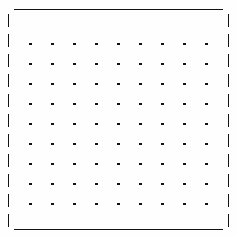
Terminology
This glossary should help the would-be Go player become more familiar with some terms used often in playing Go games, at least at the beginner level. Don't worry if some of these words mean little or nothing at this point; all will become clear in time. And please do not think ill of life if some words you felt you were fully intimate with now suddenly take on new meanings; this is only natural and the anxiety will pass quickly.
Alive - A group which is safe from capture, almost always by having two 'eyes'.
Atari - Not a major gaming corporation. This is equivelant to check in chess, being a statement that a stone faces certain capture on the next turn unless its situation is altered, typical via a strong connection.
Capture - To remove - imprison - a stone by stripping it of all 'liberties'. Not nearly as dirty nor as exciting as it sounds, unless of course you happen to be the one capturing, then it can turn out to be quite exciting.
Connection2 - Being adjacent to another stone of the same colour.
Dan - Not a young man from Ireland. Pronounced like 'dawn'. A term referring to the rank of upper level sanctioned players. More on sanctioning later.
Dead - The opposite of alive, naturally.
Eye - One of at least two liberties surrounded on all sides by stones from the same group, and nonadjacent to the other eye(s). These places are always suicide plays in fully-fledged Go.
Group - A number of stones which are directly connected on adjacent points.
Handicap - Giving one player a slight advantage by placing a number of stones onto the board at the beginning of play. Whether or not handicap is appropriate, and how many stones are placed down, is determined according to sanctioned play ranking.
Kyu - Pronounced like the letter 'Q'. A term referring to the rank of lower level sanctioned players. More on sanctioning later.
Liberty - A free point directly adjacent to a stone. A stone3 is said to 'own' or 'have' such points.
Prisoner - A stone which has been captured.
Star Point - One of nine points marked on a Go board, typically by a small dot. These points represent certain special properties of the Go board which shall become apparent to the seasoned player, and are also the points used for placing handicap stones.
Stone - The term for the tokens used in Go, whether or not they are in fact stones. Deal with it.
First-capture Go
It is typical to learn Go based on a simplified rule set, known simply as 'first-capture'. This version is swiftly learned, and surprisingly fun and challenging to the newcomer, helping you build vital skills and strategies into a foundation upon which to build your advantages in fully fledged Go. For beginners a 9x9 board is used, thus requiring each player to have 81 stones each, enough to cover the entire playing field.
Players place one stone per turn, and that is the end of their duties. While this may seem to doom the game into tedium, it actually is key to the sorts of strategy involved, and thus makes it even more intriguing despite all appearance to the contrary. The player with the black stones always goes first; whether it seems particularly fair or not. (Don't worry, White - you'll get your turn later.)
Stones are placed on the grid intersections, as stated before, including edge and corner points, and do not move once played except when captured and thus removed. Stones of the same colour which touch along a line or lines form a group and share their liberties. Thus in order to capture the stone in a group, you must deprive the entire construction of its liberties. Diagonal positions do not count, only those connections made along the vertical and horizontal lines of the grid make valid groups.
In first-capture Go, the winner is the first player to make a successful capture. Hence the (redundant) name of this rule set. And that is all you need to know to start playing! However, for the sake of simplicity and sanity preservation, here are some illustrations.
Sample Situations
X=Black
O=White

There are four groups on this board, each colour having one group of three and one solitary.
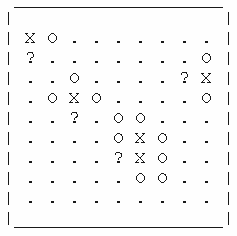
Assuming it is White's turn, White can make an easy capture at any point marked with a '?'.
Assuming it is Black's turn, Black can defend by playing at any point marked with a '?', making each group stronger (strength being a reference to the number of liberties a group has).

Playing at any point marked with a '?' would be a suicide play for Black as it would result in immediate capture. A stone played at any of these positions would have no liberties to begin with. This is surrender.
@=White
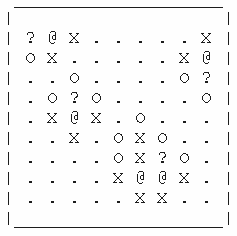
If Black plays at any point marked with a '?', it would not be a sacrifice play. Rather, the white stone(s) marked with a '@' would be captured, so that Black ends up with at least one liberty, and in fact with the win.
And that's really all you need to get going. If you read no further than this, you would know all you must to get going with Go! However, it would be wise and convenient to continue.
Handicapping and Sanctioning
If you've been sneaky and have played a few games already, you've surely noticed that as expected, some people seem to win a lot more often than others. Now, an easy win is a bore, and an imminent loss is certainly no fun4, so to bring some amount of equality back into the game one imploys the handicapping rule.
The weaker player always plays Black and places a number of stones onto the board ahead of time. The number of such stones is decided according to the ranking of each player. If you are not a sanctioned player, you and your friend(s) can easily keep track of each others streaks and use that as a measurement. Usually players begin at a rank of 30 Kyu. If you begin winning more than half your games, your rank goes to 29 Kyu, and so forth. When you reach 1 Kyu, the next level is 1 Dan, going no further than 7 Dan for amateur players, or 9 Dan for professionals. A professional at rank 1 Dan is roughly equivalant to an amateur at 7 Dan.
Now then, if one player is at 30 Kyu and the other is at 27 Kyu, then the handicap is 3 stones. Simple enough? Simply subtract the weaker player's rank from the stronger player's, and that is the number of handicap stones to play, with a limit of 9. However if both players are of the same rank, then they take turns at playing Black, and place no handicap stones, or similarly if the rank difference is only one, then the weaker player simply always plays Black and gets no handicap.
Certainly the precise placement of these stones is important. This is what those star points are good for! These are the places where the handicap stones should be placed5. The following diagrams will help on your 9x9 beginners' board.
@=Handicap Stone
X=Star Point

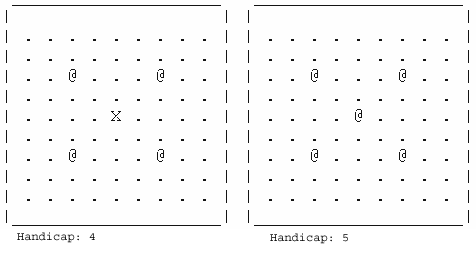
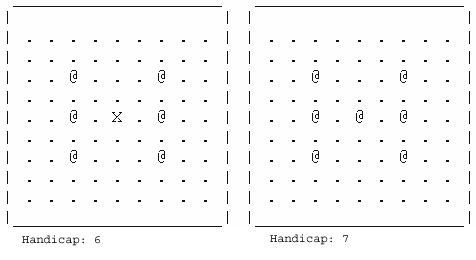
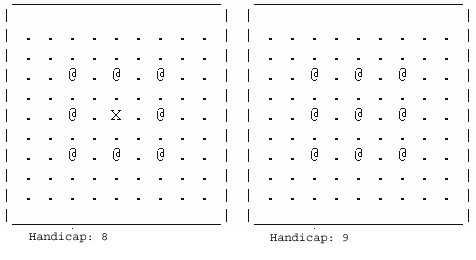
As you have likely gathered the star points are at very specific places on the board. Namely, the centre point, the third-line-in corner points, and halfway between those. One last rule: despite the weaker player's being black, the handicap is considered their opening move, and as such white actually acts first. This, too, is to preserve balance.
In Conclusion
If you find the potential behind the game of Go seriously intriguing, you can find out more information by visiting any of the links listed below, or by checking your local bookshop for materials, such as The Book of Go, by William S Cobb, which is an incredable primer into the game, or Teach Yourself Go, by Charles Matthews, a virtual encyclopedia of the game including both useful tactics as well as the history and culture of the game. Now get out and enjoy many hours of laying stones!
Related Links
- American Go Association
- British Go Association
- Canadian Go Association
- European Go Federation
- Go @ Google.com
- Kiseido Internet Go

